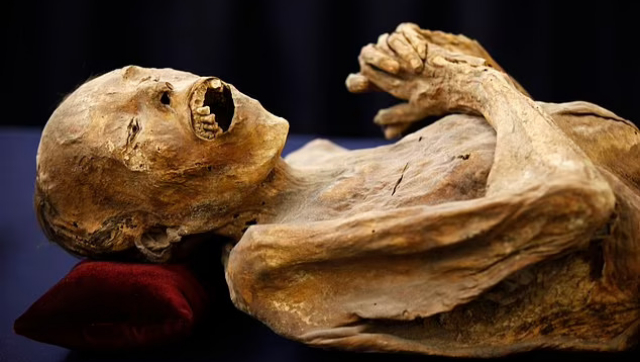Experts have cautioned that a preserved body that was accidentally mummified in the 1800s and is now on display in Mexico may have ‘fungal growths’ that could spread to tourists.
Scientists are worried that the mummy, which is one of a half-dozen bodies in glass cases on display at a tourist show in Mexico City, could endanger the public.
Playing fast and loose with public safety It is unknown whether the cases are airtight, and there are concerns that they are being displayed “without the safeguards for the public against biohazards."
When the preserved bodies were interred in crypts in arid, mineral-rich earth in the state of Guanajuato, they were accidentally mummified.
They were dug up and displayed beginning in the 1860s because their families could no longer afford funeral costs.
According to Mexico’s National Institute of Anthropology and History, several of the bodies still have hair, leathery skin, and their original attire, while one appears to have fungus growths.
They are among a collection of mummies usually on display at the Museo de las Momias in Guanajuato’s state capital, but they have moved before, and some were displayed north of the border in the United States in 2009.
Victims of a cholera outbreak on display Some of the mummies whose bones have been naturally preserved have been buried living or perished in a cholera outbreak, but this has not been confirmed.
The federal institute distanced itself from a decision by the state government to exhibit the mummies in glass cases at the tourist expo, adding that it had not been informed about the display.
“It is even more concerning that they are still being displayed without protections for the public against biohazards,” said the centre.
“From some of the published photos, at least one of the corpses on display, which was inspected by the institute in November 2021, shows signs of a proliferation of possible fungus colonies,” the institute wrote.
“This should all be thoroughly examined to see if these are signs of a threat to the cultural legacy, as well as those who manage and visit them.”
The specialists did not expand on the sort of fungal growths in their statement.
Natural mummification may have preserved the pathogens as well The mummies were kept naturally, which some attribute to the local climate and mineral-rich surroundings. Others think it was because they were kept in enclosed crypts, but no one is certain.
Natural mummification is described as the process of preserving the epidermis and organs of a dead individual or animal without the use of chemicals.
It is uncommon and only occurs in certain circumstances.
The Museo de las Momias, which receives over 4,000 visitors per week, costs £2 to view more than 100 desiccated human cadavers that have been disinterred from tombs in the graveyard next door.
The museum showcases murder victims, criminals who were buried alive, and infants put to rest costumed as saintsm which Mexicans believe that it will smooth their journey to paradise.
Read all the Latest News , Trending News , Cricket News , Bollywood News , India News and Entertainment News here. Follow us on Facebook , Twitter and Instagram .


)




)
)
)
)
)
)
)
)